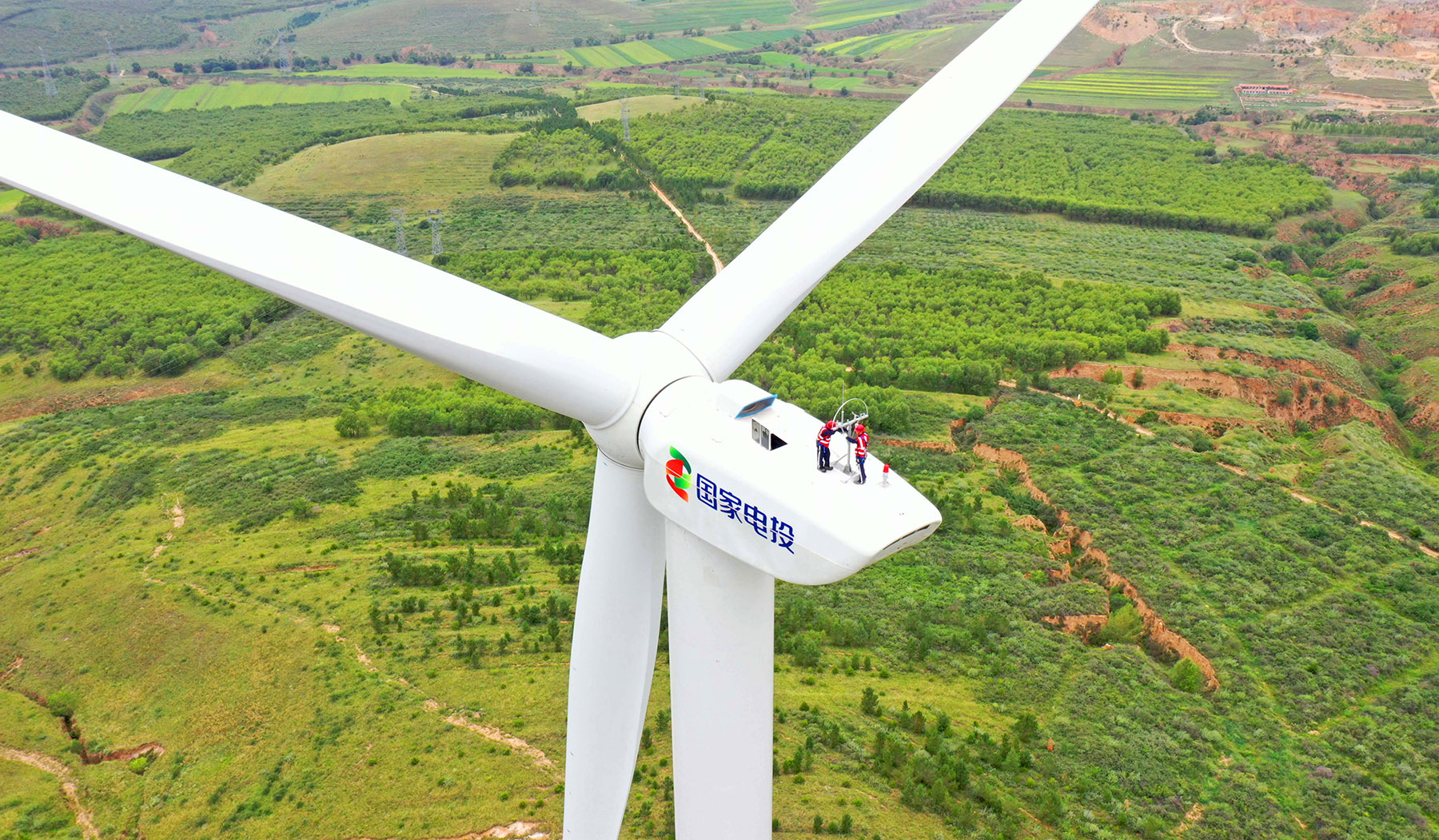Focus on spurring independent ops in monopolistic sectors; reforms boost competition

Market-oriented reforms are set to define major directions of the energy sector's development in the coming years, said experts, highlighting content discussed at the recently concluded third plenary session of the 20th Central Committee of the Communist Party of China.
Experts said the third plenary session reiterated the significant role of the market in driving the development of new energy, industrial decarbonization, ensuring stable energy supply and establishing a new energy system.
READ MORE: CPC charts growth blueprint
Specifically, it emphasized advancing independent operations in monopolistic sections and market-oriented reforms in competitive areas of the energy sector, and refining mechanisms for private enterprises to participate in national projects effectively. It advocated for reforms in pricing across the water, energy and transportation sectors, optimizing tiered pricing systems for residential water use, electricity and gas consumption, as well as enhancing refined fuel pricing mechanisms.
Concurrently, efforts to accelerate the planning and construction of a new energy system with improved policies for integrating power generated from new energy sources into the grid and regulating renewable energy consumption were highlighted in the discussions of the third plenary session.
Everbright Securities said monopolistic operations in the power sector primarily refer to the grid segment. It said the previous round of electricity reforms since 2015 already proposed "controlling the middle while opening up both ends", aiming to achieve independent operation of the grid and transparency in revenue. The current challenge lies in the pressure from integrating new energy into the grid, necessitating increased investment, enhanced digitization and greater flexibility, posing higher requirements for the stable and profitable operations of the grid network.
"The new decision on advancing independent operations in monopolistic sections, mainly the grid sector, is a step forward in the 2015 electricity market reform to deal with challenges, mainly stability and profitability issues, after more power from renewable sources connects to the grid. The grid now has almost achieved the level of independent operations with minor adjustments that need government intervention, such as required absorption ratio of power from new energy resources," said Lin Boqiang, head of the China Institute for Studies in Energy Policy at Xiamen University.
Competitive market segments have seen the marketization of thermal power operations in the previous round of reforms, said Everbright Securities. However, methodologies for marketizing new energy — as well as power pricing mechanisms that coordinate electricity from new energy resources and thermal power sources — are not yet fully developed.
In terms of advocating electricity price reforms mentioned in the third plenary session, experts said further efforts are needed to focus on improving the electricity trading market, forming competitive pricing models for new energy and integrating electricity with carbon pricing.

Regarding the enhancement of refined fuel pricing mechanisms, Su Qilong, general manager of the Dalian Petroleum Exchange, said that while the current pricing system has stabilized oil supply in the domestic oil market, recent geopolitical conflicts have led to volatile international oil prices that do not suit domestic supply and demand dynamics.
Su suggested increasing transparency in the pricing mechanism, proposing further reduction of adjustment periods beyond the current 10-day cycle, and optimizing controls on price ceilings and floors.
Liu Yijun, a professor at China University of Petroleum, said residential gas prices influence the overall gas price reform process. One key aspect is the linkage mechanism that coordinates prices from suppliers and users. Currently, residential gas prices generally remain low with insufficient frequency of adjustments, and some regions lack such mechanisms, which puts pressure on suppliers. These areas require further optimization and improvement.
Addressing the improvement of policies for integrating and regulating new energy consumption as outlined in the decision made by the third plenary session, Li Qionghui, a researcher from the State Grid Energy Research Institute, said, "China is witnessing the emergence of a diversified new energy absorption and consumption mechanism, encompassing required grid absorption of power from new energy sources, market-oriented consumption, integrated suppliers-grid-users-storage systems and distributed consumption."
In May, an action plan issued by the State Council — the nation's Cabinet — proposed relaxing the required absorption ratio of power generated from new energy sources from 95 percent to 90 percent for the grid in certain regions, contingent upon dynamic annual assessments of absorption conditions. Li said that this adjustment will further accelerate the marketization of electricity generated from new energy resources.
"Future policies will further enhance the grid compatibility of new energy integration, and peak-shaving capabilities," Li added.
Wang Bohua, honorary chairman of the China Photovoltaic Industry Association, said that relaxing the required absorption rate of green power for the grid from 95 percent to 90 percent, combined with accelerated large-scale project construction and faster grid development — along with support for distributed new energy development (such as rooftop photovoltaics) — will create significant opportunities for new energy development. Consequently, China's photovoltaic installed capacity is expected to remain high.
Earlier, data from the China Electricity Council showed that by the end of June, the combined installed capacity of wind and solar power in China surpassed that of coal power for the first time, reaching 1.18 billion kilowatts compared to coal power's 1.17 billion kW.
"As end-use energy becomes more electrified and electricity consumption becomes low-carbon, new energy will gradually become the primary energy source in the power generation process. Meanwhile, electricity reforms are advancing improved electricity pricing mechanisms, and more efforts will be made to promote distributed PV's participation in electricity trading," Wang said.
Talking about the establishment of a new type of energy system that was underlined in the decision of the third plenary session, Lin said the proportion of new energy in the energy system continues to rise, and its impact on grid stability is also increasing, thus posing greater need for a new adjustment system. Lin said that the essence of a new type of energy system lies in primarily relying on wind and solar power as the main electricity resources, complemented by corresponding grid stability and coal-fired energy supply support.
Ouyang Minggao, an academician at the Chinese Academy of Sciences, emphasized the necessity of implementing new types of energy storage methods.
He said new types of energy storage include long-cycle, cross-seasonal flexibility adjustments using hydrogen and its carriers, electrochemical energy storage for mid-term adjustments within eight hours, and electric vehicle energy storage for vehicle-to-grid interactions.
ALSO READ: China sets example for green transition
A recent report from the China Renewable Energy Engineering Institute revealed that China's cumulative installed capacity of new types of energy storage exceeded 31 gigawatts as of the end of last year, a nearly tenfold increase over the past three years, with lithiumion storage accounting for 97.4 percent, and compressed air storage entering the accelerated development stage.
"Constructing a new type of energy system requires both ensuring stable energy supplies and increasing the proportion of clean energy, which opens new opportunities for new technologies such as smart grids and carbon capture, utilization and storage technologies," Lin said.
He said CCUS is an important technological choice for balancing energy security and carbon reduction. Facing challenges posed by the limited share and intermittency of renewable energy resources, together with increasing global energy market volatility and heightened post-pandemic development pressures, many countries, especially developing ones, approach energy restructuring cautiously. Against this backdrop, ensuring stable energy supplies while promoting carbon reduction has become equally imperative.
Lin said CCUS technology, primarily applied in high-emissions sectors such as coal-fired power generation, petrochemicals and steel production, facilitates low-carbon utilization of fossil fuels. It plays an important role in stabilizing global energy transformation and serves as a significant technical means for countries to reduce carbon emissions while maintaining stable fossil fuel consumption.


